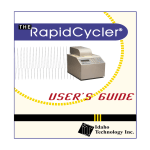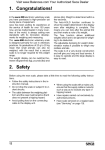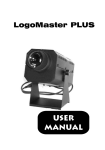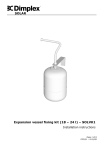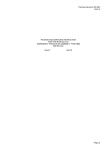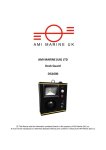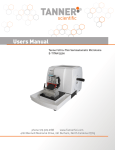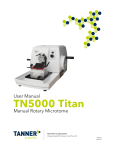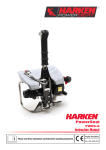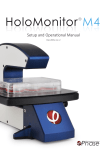Download OPERATING MANUAL, ERMA RADIAL
Transcript
OPERATING MANUAL, ERMA RADIAL INSTRUCTIONS FOR ASSEMBLY AND OPERATION OF ERMA MICROTOME Upon receipt of your Erma Microtome please check the contents of the packages (s). These are itemized below: 1. 2. 3. 4. 5. Microtome Vise (object clamp) Knife (in a wooden box) Knife Handle Tommy Bar Before attempting to operate your Erma Microtome, please familiarize yourself with the component parts shown in Fig. 1. PARTS IDENTIFICATION 1. Tommy Bar 2. Knife Clamping Screws 3. Slider Bearing Surface 4. Slider Bearing 5. Rotary Bearing 6. Rotary Bearing Adjustment Screw C 7. Rotary Bearing Adjustment Locknut B 8. Slider Bearing Adjustment Screw E 9. Slider Bearing adjustment Locking Nut D 10. Stage Height Adjustment Handle 11. Cutting Thickness Adjustment Lever 12. Thickness Gauge 13. Cutting Angle Adjustment Screw A 14. Cutting Angle Gauge 15. Vise Block Pillar Release OPERATING INSTRUCTIONS CONTENTS 1. 2. 3. 4. 5. 6. 7. Mounting the Micro Tome Mounting of Object Clamp or Freezing Stage Raising or Lowering Object Clamp or Stage Setting Cutting Thickness Mounting the Knife Operation Cleaning & Lubrication 8. Routine maintenance 9. Warranty information 1. Mounting the Microtome Your Erma Microtome should be mounted on the edge of a sturdy bench, 1 ½” thick or less, using the mounting clamp at the rear of the microtome. 2. Mounting the Object or Freezing Stage The microtome is normally supplied fitted with the object clamp. This is used for paraffin embedded specimens. The Tommy bar underneath the vise releases the pillar attached to it enabling the user to rotate the vise to any convenient position or, by pulling upwards, remove the complete vise assembly. The sliding arm should be pushed to the rear to facilitate its removal. If a Sensortek thermoelectric freezing stage is being used with the microtome the object clamp must be removed and the stage, supplied with its own pillar, substituted. The water tubes and power cables should be led out at the rear of the microtome and taken to a supply of cooling water and the power unit ass described in the instruction manual supplied with the freezing stage. 3. Raising or lowering the Object Clamp or Freezing Stage Pull the sliding arm toward the front of the microtome to release the ratchet mechanism. Wind the handle on the bottom of the microtome in a clockwise direction to raise the stage, counter-clockwise to lower it. 4. Adjustment of Cutting Thickness Section thickness can be set in 5 micron steps by depressing the cutting adjustment lever and moving to the left to reduce or to the right to increase cutting thickness. A range of 5 to 40 microns (10 - 6 meters) can be accommodated on this microtome. 5. Mounting the Knife Lift the knife from the box and carefully remove the oiled paper wrapping. Clean the knife with a grease solvent. Inspect the edge of the knife for nicks before installation. (See section for instructions in care and sharpening of your knife). Unscrew the knife clamping screws on the top of the sliding arm and insert the knife from the right side. Retighten the screws to retain the knife. The cutting angle is set by loosening screw A with a Tommy bar and setting the cutting angle to the gauge. Cutting angles are adjustable from cutting angle to the gauge. Cutting angles are adjustable from 0 to 10 . Retighten screw A after setting preferred angle of cut. 6. Operation Mount the specimen into the vise or freeze it onto the surface of your Freezing Stage, bringing the top of the specimen to within a millimeter or so of the knife cutting edge as explained in Paragraph 3. press lightly down on the slide arm and move it forward all the way, then back all the way. This will cut the specimen and then automatically raise it by the next section. Frozen sections should be caught on a small spatula and floated onto the surface of a water bath (such as a petri dish) to flatten. They can then be readily transferred to a microscope slide. If the frozen tissue touches the knife it melts and tends to collapse. 7. Cleaning & lubricating After use, especially when a freezing stage has been used, wipe up all condensation and moisture on the bright parts of the microtome. Cover with a light oil to prevent corrosion. The knife should be removed and cleaned in a similar manner and repacked in its box to prevent any damage to the cutting edge. Always replace the soft plastic dust cover over the microtome after use. 8. Routine Maintenance 8.1 Keep the running thread and slider surface well oiled and clean. Check tightness of all nuts and screws periodically. 8.2 Rotary bearing adjustment - Adjustment of the bearing tightness can be made by slacking off locking nut B using the Tommy bar. Turn screw C in a clockwise direction to increase tightness. After adjustment hold screw C and retighten B. 8.3 Slider bearing adjustment - Binding or looseness of the slider foot can be cured by slacking off the locking nut D and turning the adjustment screw E clockwise to tighten, counter – clockwise to loosen. Retighten locking nut D when the operation has been completed. 8.4 Knife should be sharpened periodically. A very dull or nicked knife should be sharpened on a special honing machine. Knife sharpening services are available in most areas. For light honing, a zimmer strop can be used. Hold the knife with the knife edge and bevel touching the surface of the strop. Draw knife rapidly over the strop with the edge to the rear. Flip the blade over and repeat on the other side. Repeat until adequate degree of sharpness is achieved, changing to successively finer surfaces as needed. 9. Repairs In the event that a microtome is to be returned for repair, please pack it carefully and send it prepaid to: SERVICE DEPARTMENT PHYSITEMP INSTRUMENTS, INC. 154 HURON AVENUE CLIFTON, N.J. 07013 Please include with the instrument: 1. A note describing any problems encountered. 2. The name and telephone number of a person we can contact. 3. The complete return address for shipping. 10. Warranty Physitemp Inc. warrants this instrument to be free from defects in material and workmanship for 12 months from date of shipment. Repair or replacement will be made at no charge at the discretion of Physitemp if the defect is not the result of the misuse or abuse. Physitemp accepts no consequential liability for delay in delivery, alleged faulty performance of the product, or any other cases. For your protection, please pack the item carefully and insure against possible damage or loss. Physitemp will not be responsible for damages resulting from careless packaging. Please return freight prepaid.






